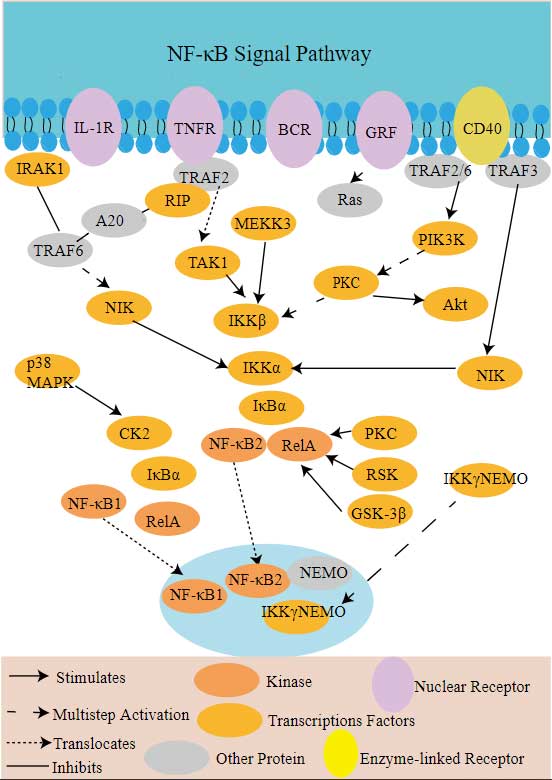MAPK3
-
Official Full Name
MAPK3 mitogen-activated protein kinase 3 -
Synonyms
MAPK3;mitogen-activated protein kinase 3;PRKM3;ERK1;p44erk1;p44mapk;MAPK 1;MAP kinase 1;MAP kinase 3;MAP kinase isoform p44;insulin-stimulated MAP2 kinase;mitogen-activated protein kinase 1;extracellular signal-related kinase 1;extracellular signal-regulated kinase 1;microtubule-associated protein 2 kinase;ERT2;ERK-1;P44ERK1;P44MAPK;HS44KDAP;HUMKER1A;p44-ERK1;p44-MAPK;MGC20180
Recombinant Proteins
- Human
- Zebrafish
- Rat
- Mouse
- E.coli
- Mammalian Cells
- HEK293
- HeLa
- Non
- GST
- His
- MBP
- DDK
- Myc
- Avi
- Fc
- Flag
Background
What is MAPK3 protein?
MAPK3 (mitogen-activated protein kinase 3) gene is a protein coding gene which situated on the short arm of chromosome 16 at locus 16p11. The protein encoded by this gene is a member of the MAP kinase family. MAP kinases, also known as extracellular signal-regulated kinases (ERKs), act in a signaling cascade that regulates various cellular processes such as proliferation, differentiation, and cell cycle progression in response to a variety of extracellular signals. This kinase is activated by upstream kinases, resulting in its translocation to the nucleus where it phosphorylates nuclear targets. The MAPK3 protein is consisted of 379 amino acids and its molecular mass is approximately 43.1 kDa.
What is the function of MAPK3 protein?
Activation of MAPK3 requires both tyrosine and threonine phosphorylation that is mediated by MEK. MAPK3 is ubiquitously distributed in tissues with the highest expression in heart, brain and spinal cord. Activated MAPK3 translocates into the nucleus where it phosphorylates various transcription factors (e.g., Elk-1, c-Myc, c-Jun, c-Fos, and C/EBP beta). MAPK3 can respond to extracellular stimuli, such as growth factors, hormones, and neurotransmitters, and activate downstream target proteins through phosphorylation. It is also involved in the regulation of immune response and can be activated by inflammatory mediators such as TNF-α and IL-1β, thus inducing the occurrence and maintenance of inflammatory response. It can also be activated by a variety of carcinogenic factors, such as Ras mutation, PTEN deletion, etc., and then promote the proliferation, invasion and metastasis of tumor cells.
MAPK3 Related Signaling Pathway
MAPK3 is an important member of the MAPK family, which can respond to a variety of extracellular stimuli, such as growth factors, hormones, neurotransmitters, and activate downstream target proteins through phosphorylation, thereby mediating cell proliferation, differentiation, apoptosis and other biological processes. MAPK3 is located between RAS GTPase and MAPK1 in the member kinase cascade, and MAPK3 can be activated by Ras proteins, which activate MAPK1 through phosphorylation, thereby regulating a variety of cell biological responses. In addition, MAPK3 can also be involved in the regulation of PI3K/AKT signaling pathway and Wnt/β-catenin signaling pathway.
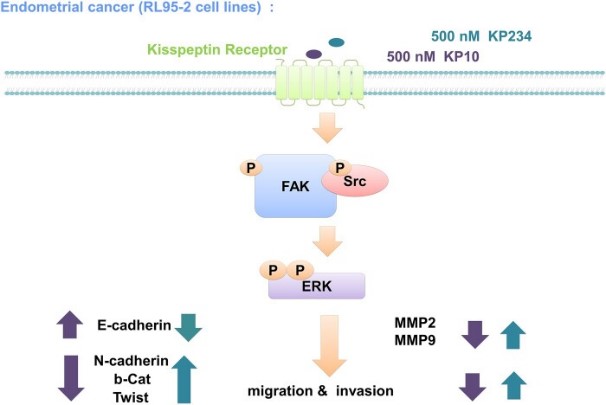
Fig1. The proposed signaling pathways involved in Kisspeptin-modulated cell invasion and migration in endometrial cancer cells. (Hsien-Ming Wu, 2024)
MAPK3 Related Diseases
MAPK3 is abnormally expressed in a variety of cancers, including breast cancer, lung cancer, and colorectal cancer. It can promote the proliferation, invasion and metastasis of tumor cells by activating MAPK/ERK signaling pathway. MAPK3 can promote neuronal survival and axon growth by activating MAPK/ERK signaling pathway, thus participating in the occurrence and development of Parkinson's disease, Alzheimer's disease and other diseases. It can also promote inflammatory response and immune response by activating NF-κB signaling pathway, thus participating in the occurrence and development of autoimmune diseases such as rheumatoid arthritis and systemic lupus erythematosus. In addition, the mutation of MAPK3 gene is associated with the occurrence of cardiovascular diseases such as hypertension and coronary heart disease.
Bioapplications of MAPK3
MAPK3 has important application value in many biological fields, and has important research significance for in-depth understanding of the mechanism of cell signaling, the mechanism of tumorigenesis, and the function and disease of nervous system and cardiovascular system. Therapeutic strategies targeting MAPK3 are also being investigated, such as the use of antibodies or small molecule inhibitors to inhibit its activity, thereby stopping tumor growth and metastasis.
Case Study
Case study 1: Jia Liu, 2016
Oleanolic acid (OA) is a natural triterpenoid that is widely distributed in edible and medicinal plants. OA exerts anti-tumor activity on a wide range of cancer cells primarily through inducing apoptosis. Dysregulated ERK signaling is closely complicated in the biology of cancer, such as metastasis, proliferation, and survival, and it can be activated by various stimuli. But it is not clear whether there is a connection between the OA and ERK signaling pathways.
In this study, by blocking ERK activation by U0126 or siRNAs was able to potentiate the pro-apoptotic activity of OA on cancer cells, the results showed that OA induced the activation of ERK in cancer cells. ERK activation compromised the apoptosis induced by OA. In conclusion, the researchers provided evidences that ERK activation is a mechanism underlying the resistance of cancer cells to OA-induced apoptosis and targeting ERK is a promising strategy to enhance the anti-tumor efficacy of OA.
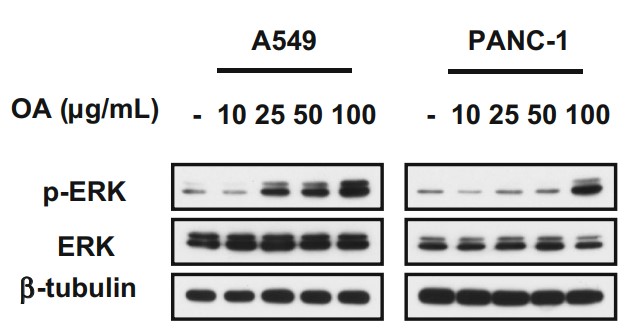
Fig1. OA induces the activation of ERK signaling in cancer cells.
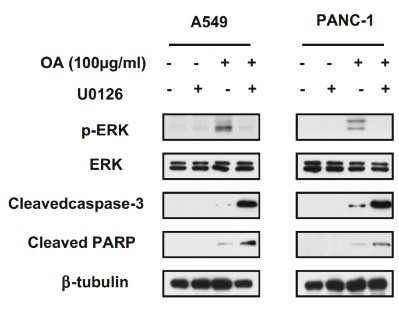
Case study 2: Yuanya Zhang, 2019
The spatiotemporal regulation of ERK activity has been extensively studied. However, scarce information has been available regarding the quality control of the kinases to scavenge malfunctioning ERKs.
Using site-specific mutagenesis and mass spectrometry, the researchers found that the disruption of the conserved H-bond between Y210 and E237 of ERK1 through point mutation at or naturally occurring nitration on Y210 initiates a quality control program dependent on chaperon systems and CHIP (C-terminal of Hsp70-interacting protein)-mediated ubiquitination and degradation. These findings clearly demonstrate how malfunctioning ERKs are eliminated when cells are in certain stress conditions or unhealthy states, and could represent a general mechanism for scavenging malfunctioning kinases in stress conditions.
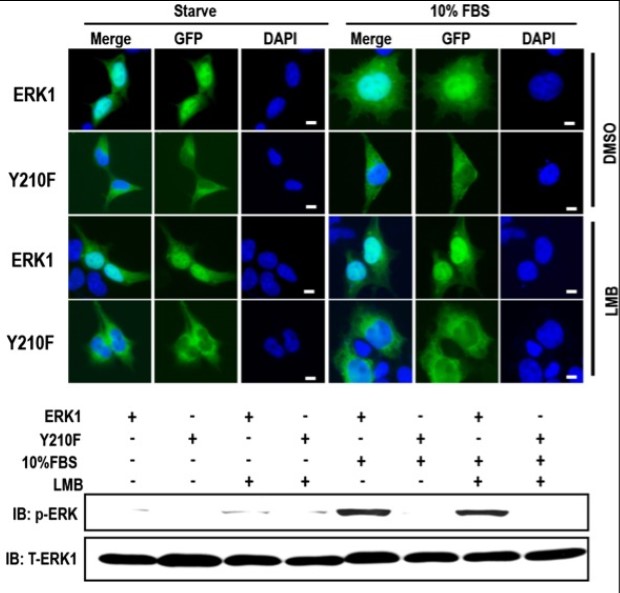
Fig3. HEK293T cells expressing GFP-ERK1 (ERK1) or GFP-ERK1-Y210F (Y210F) were serum-starved overnight and then treated with the nuclear export inhibitor LMB (40 mM) or vehicle (DMSO) for 3 h as indicated.
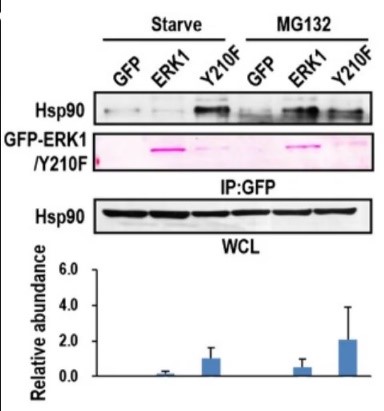
Quality Guarantee
High Purity
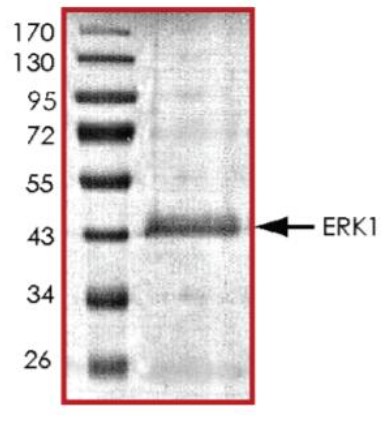
Fig1. SDS-PAGE (MAPK3-307H) (PROTOCOL for western blot)
.
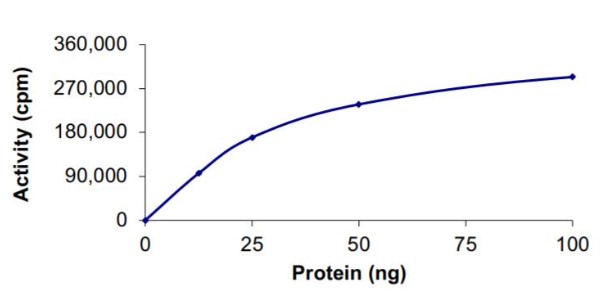
Fig2. Activity Data. (MAPK3-307H)
Involved Pathway
MAPK3 involved in several pathways and played different roles in them. We selected most pathways MAPK3 participated on our site, such as MAPK signaling pathway,ErbB signaling pathway,Ras signaling pathway, which may be useful for your reference. Also, other proteins which involved in the same pathway with MAPK3 were listed below. Creative BioMart supplied nearly all the proteins listed, you can search them on our site.
| Pathway Name | Pathway Related Protein |
|---|---|
| Pertussis | CALM3,C4BPB,CXCL5,GM5077,CALM4,IRF1,ITGB2L,NLRP3,CALM2,CALML5 |
| Colorectal cancer | MLH1,AXIN2,PIK3R3,AXIN1,BCL2,RHOA,MAPK10,MAPK1,MSH3,TGFBR2 |
| Long-term potentiation | RAP1B,GRIN2B,CALM3,ITPR3,CALM4,GRIN1,CAMK2A,PPP3CB,CAMK2B,GRIN2A |
| Aldosterone-regulated sodium reabsorption | INS2,ATP1B2,KRAS,NEDD4L,NR3C2,PDPK1,FXYD4,SCNN1B,ATP1A4,HSD11B2 |
| Viral carcinogenesis | HDAC9,CREB3L2,TTC6,DLG1,HIST1H4K,KRAS,HIST2H2BB,PIK3R5,TRAF3,CREB5 |
| Salmonella infection | PLEKHM2,RHOGB,RHOGD,ARPC4L,RAB7B,IFNG,IFNGR2,ARPC5A,MAPK12,RHOG |
| Glioma | PIK3R5,TP53,SHC3,SHC2,TRP53,ARAF,Pdgfa&Pdgfb,MAP2K1,PIK3CA,CAMK2B |
| Proteoglycans in cancer | PRKACB,DROSHA,HPSE2,ROCK2,MTOR,VEGFA,COL21A1,CDC42,RAF1,WNT6 |
| Non-small cell lung cancer | PIK3CG,ARAF,RASSF1,AKT2,PIK3CD,RXRB,CCND1,CASP9,RAF1,ERBB2 |
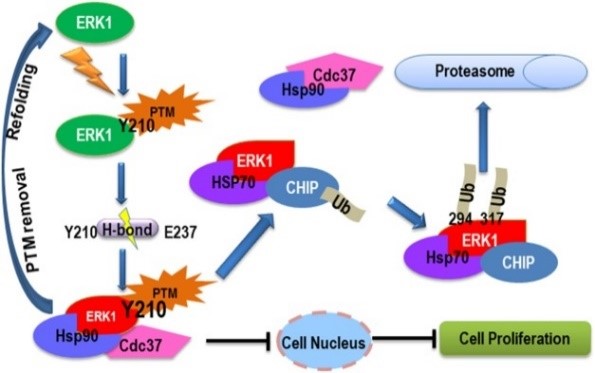
Fig1. The diagramed model shows Y210 modification-induced ERK1 ubiquitination and degradation. (Yuanya Zhang, 2019)
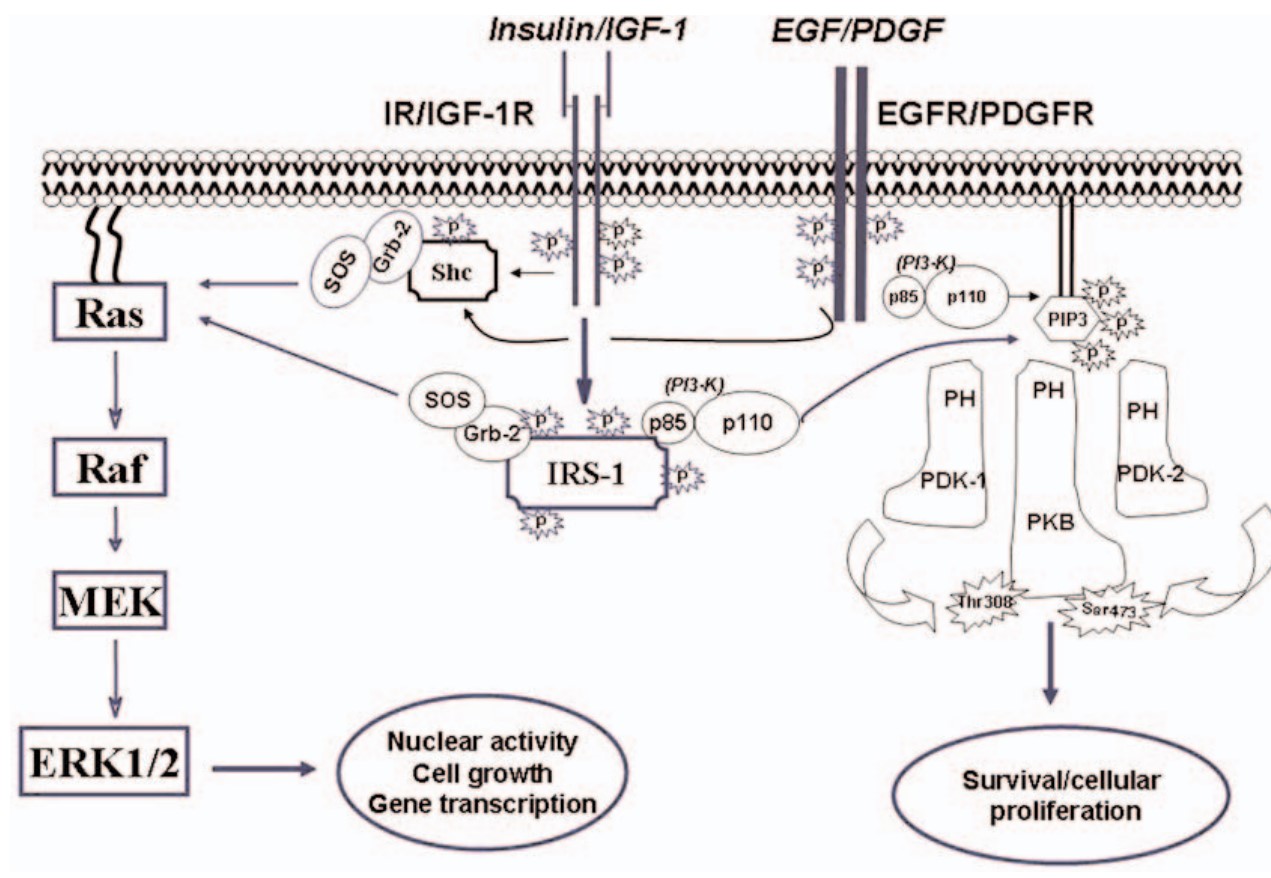
Fig2. BMPs signal via the canonical, Smaddependent pathway or various non-canonical pathways. (Mohamad Z Mehdi, 2007)
Protein Function
MAPK3 has several biochemical functions, for example, ATP binding,MAP kinase activity,phosphatase binding. Some of the functions are cooperated with other proteins, some of the functions could acted by MAPK3 itself. We selected most functions MAPK3 had, and list some proteins which have the same functions with MAPK3. You can find most of the proteins on our site.
| Function | Related Protein |
|---|---|
| phosphatase binding | KIAA0649,SPRED1,DYSFIP1,SH3YL1,CRY1,TSC2,SMAD3,WNK1,PPP1R36,PPP1R35 |
| scaffold protein binding | GRIN2A,CACNA1H,CASP8,DLG4,CACNA1G,PANX1,SHANK1,ADCY6,MDM2,CHUK |
| protein binding | SLC30A3,YTHDF3,RFX3,RANBP6,GRHL2,PSIP1,MPP1,RPL27A,C1orf187,LOC780933 |
| phosphotyrosine binding | CBL,STAP1,ACP2,ZAP70,MAPK1,CBLB,LDLRAP1,SHC1,CBLC,PTPN3 |
| MAP kinase activity | MAPK7,MAPK8B,MAPK13,MAPK1,MAPK8A,MAPK11,MAPK14B,NLK,MAPK12,MAPK14A |
| ATP binding | PAK4,CDC42BPA,MAT2AA,CDK9,ATP1A3B,FIGNL1,PRKAA1,KIF18B,HSPA1L,SBK1 |
Interacting Protein
MAPK3 has direct interactions with proteins and molecules. Those interactions were detected by several methods such as yeast two hybrid, co-IP, pull-down and so on. We selected proteins and molecules interacted with MAPK3 here. Most of them are supplied by our site. Hope this information will be useful for your research of MAPK3.
DUSP1;PTPRJ;MAPK14;DHPS;Ptprr
MAPK3 Related Signal Pathway
Resources
Research Area
- Cancer Drug Targets
- Apoptosis Intracellular Kinases
- Histone Phosphorylation
- Intracellular Kinases in the Akt Pathway
- ROS and Stress Resistance
- ERK (Extracellular Signal-regulated Kinases)
- Negative Regulators of the Jak/STAT Pathway
- Positive Regulators of the Jak/STAT Pathway
- Intracellular Signaling Molecules in Angiogenesis
- EMT Induction
- Natural Killer T (NKT) Cells
- Reperfusion Injury Therapeutic Targets
- C-type Lectin Receptors
- IL-1 Family Signaling Molecules
- IL-17 Signaling Related Molecules
- RAS-MAPK Pathway
Related Services
Related Products
References
- Blaha, M; Nemcova, L; et al. Cyclic guanosine monophosphate does not inhibit gonadotropin-induced activation of mitogen-activated protein kinase 3/1 in pig cumulus-oocyte complexes. REPRODUCTIVE BIOLOGY AND ENDOCRINOLOGY 13:-(2015).
- Chen, TC; Lin, KT; et al. Using an in Situ Proximity Ligation Assay to Systematically Profile Endogenous Protein-Protein Interactions in a Pathway Network. JOURNAL OF PROTEOME RESEARCH 13:5339-5346(2014).


